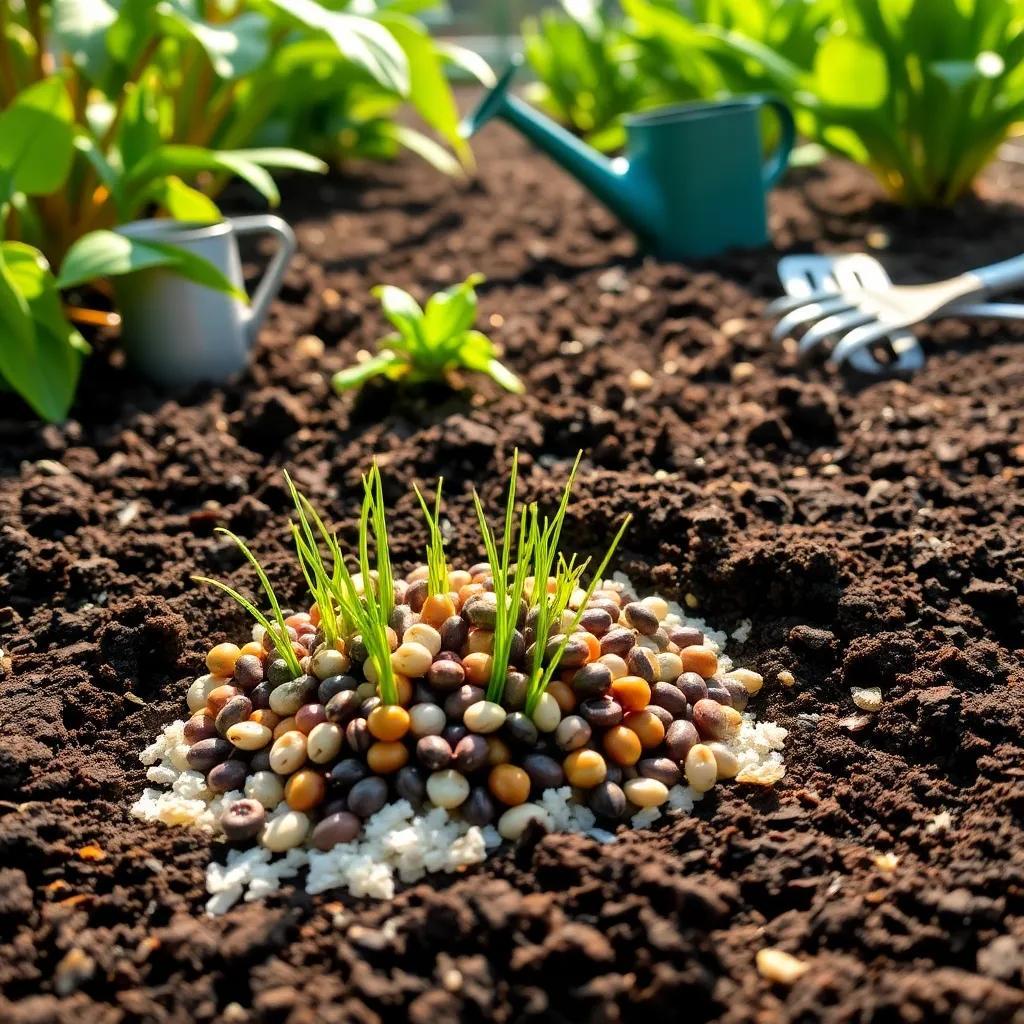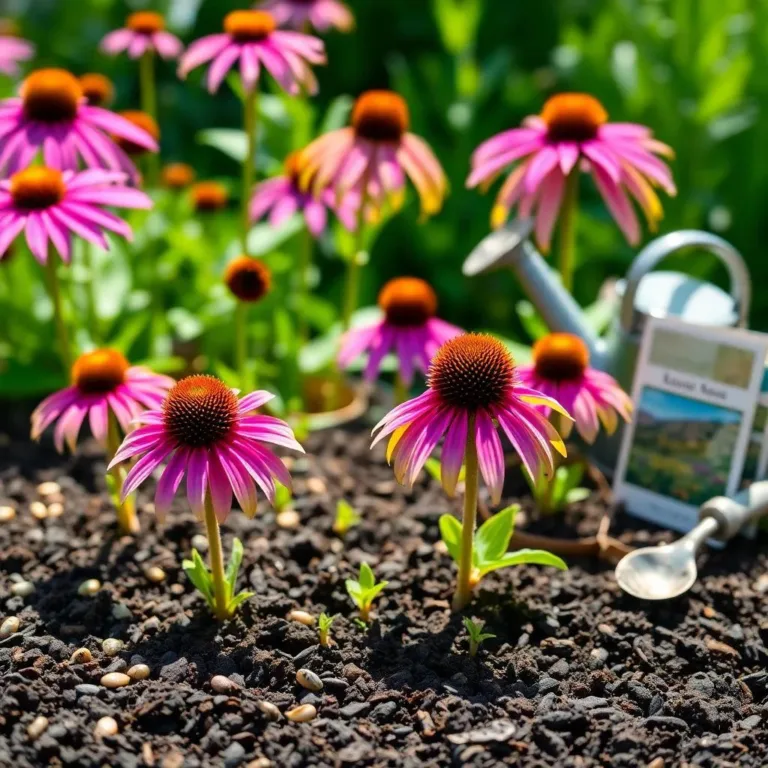Are you ready to watch your garden come alive with beautiful coneflowers? Growing these vibrant flowers from seeds is not just a fun project, it’s also super rewarding! Join me as we explore the secrets to successful germination, and I’ll share tips and tricks that will have your garden blooming in no time!
Ideal Conditions for Successful Coneflower Germination
Getting your coneflower seeds to germinate is like creating the perfect recipe! Just like you wouldn’t bake a cake without the right ingredients, you need to set up the ideal conditions for your coneflowers to sprout. So, what do you need to make this happen? Let’s break it down!
- Soil Preparation:
The first step is preparing the soil. Coneflowers love well-draining soil with a pH between 6.0 and 7.0. You can check the pH using a simple test kit from your garden store. Loosen the soil with a garden fork or tiller, and make sure to remove any weeds or rocks. Adding organic matter, like compost, really boosts fertility and helps the soil hold moisture. Who doesn’t want happy plants, right?
- Timing Your Planting:
Timing is everything! I like to plant my seeds in early spring or fall when the soil is warm and moist. Avoid the harsh extremes of summer or winter. Mother Nature can be a bit unpredictable, so keep an eye on the weather!
- Watering Wisely:
Water is my best friend during germination. After sowing the seeds, give them a gentle drink. Aim for moist but not soggy soil. Overwatering is like overcooking pasta—nobody wants that!
- Light Levels:
While coneflower seeds don’t need a ton of light to sprout, once they do, they crave sunshine! Make sure they get at least 6-8 hours of sunlight daily. If you’re starting them indoors, consider using grow lights to keep them cozy.
- Patience and Care:
Last but not least, patience is key. Germination can take anywhere from 10 to 21 days. Yes, it might feel like waiting for a pot of water to boil, but trust me, the wait will be worth it!
Creating the right conditions will help those beautiful coneflowers pop up and fill your garden with color.
Step-by-Step Guide to Germinating Coneflower Seeds
Alright, friend! Now that we’ve got the ideal conditions set up, let’s dive into the step-by-step guide for germinating those lovely coneflower seeds. It’s super simple, and I promise you’ll be thrilled to see your little sprouts in no time!
- Choose Your Spot:
Find a sunny location in your garden. Coneflowers thrive in areas that get plenty of sunlight. Remove any debris, rocks, or weeds. We want to create a clean slate!
- Sow the Seeds:
Now it’s time to scatter your coneflower seeds over the prepared soil! I usually sprinkle them evenly, avoiding overcrowding, which can lead to competition for nutrients.
- Press Down Gently:
Give those seeds a little push! Lightly press them into the soil. This helps them make good contact. It’s like tucking them into bed—nice and snug!
- Cover Them Up:
Cover the seeds with a thin layer of soil or vermiculite. Think of this as putting a cozy blanket over your seeds to keep them warm and protected.
- Moisten the Soil:
After sowing, give the soil a gentle watering to keep it moist. Regularly check in on them. Just remember, consistency is key!
- Light, Light, and More Light:
Place your seed trays or pots in a space that gets indirect sunlight. If you’re starting them inside, don’t forget those grow lights!
- Monitor and Water:
Keep an eye on the moisture level. Make sure it stays consistently moist, but not drenched. This will promote healthy growth.
- Germination Time:
Keep your patience hat on! In about 10 to 21 days, you’ll see those little green shoots breaking through the soil!
With these simple steps, you’ll be well on your way to sprouting beautiful coneflowers that will brighten up your garden. Let’s get growing!

Germination Times for Popular Coneflower Varieties
When it comes to growing coneflowers, knowing the germination times for different varieties can be super helpful. Did you know that not all coneflowers sprout at the same speed? Let’s look at some popular types and their typical germination periods. I’ve found this knowledge can really help in planning my garden!
- Echinacea purpurea:
This is probably the most well-known coneflower, often seen with its stunning purple petals. The seeds usually germinate in 10 to 20 days, and sometimes as quick as 7 days! So keep your eyes peeled!
- Echinacea angustifolia:
This variety is native to North America and sports beautiful pale pink to purple flowers. Expect germination around 10 to 21 days. A little patience goes a long way!
- Echinacea paradoxa:
With its eye-catching yellow petals, this one is a showstopper. The seeds generally take about 10 to 20 days to germinate. It loves well-drained soil and full sun.
- Echinacea pallida:
Known as the pale purple coneflower, it usually germinates within 10 to 21 days. Its drooping petals add a unique charm to any garden!
- Echinacea tennesseensis:
This variety is a bit quicker, with germination typically occurring in 10 to 14 days. Its slender petals are a lovely addition to my garden!
Knowing these times helps me plan better and manage my expectations. It’s a delightful way to watch nature work! Just remember, factors like temperature and moisture can affect how quickly they sprout, so don’t lose hope if things take a little longer!
Techniques to Accelerate Coneflower Seed Germination
Are you as excited as I am to get those coneflower seeds sprouting quickly? There are several tips and tricks we can use to speed up germination! With a little extra care, you’ll be enjoying your lovely blooms even sooner. Here are some effective techniques:
- Pre-soaking the Seeds:
Soaking seeds in water for about 24 hours before planting can soften the hard outer coat. This little trick works wonders and can encourage quicker germination!
- Scarification:
For those seeds with tough shells, let’s give them a bit of a “spa treatment”! Lightly nicking or scratching the seed coat with a sharp knife or sandpaper can help moisture enter and boost germination rates.
- Stratification:
Mimicking winter conditions can be helpful for certain varieties. Placing seeds in a damp paper towel inside a plastic bag in the refrigerator for 4 to 6 weeks breaks dormancy and prepares them for planting.
- Optimal Temperature:
Keep the temperature in the sweet spot! For coneflowers, 70-75°F (21-24°C) is ideal. A heat mat can help maintain the perfect warmth, giving those seeds a cozy environment.
- Moisture Control:
Consistent moisture is key! Make sure your soil is moist but not drenched. Misting the surface regularly can help keep the moisture level just right.
- Using a Seed Starting Mix:
Planting in a specially formulated seed starting mix promotes faster growth by providing the right balance of moisture retention and drainage.
By employing these techniques, you’ll not only speed up the germination process but also set your coneflowers up for a happy and healthy life! Exciting, right? Just remember, every seed is unique, so take your time, enjoy the journey, and watch the magic happen!
Common Challenges in Coneflower Germination and Solutions
As thrilling as growing coneflowers can be, it’s not all sunshine and rainbows! Sometimes, we face a few hiccups along the way. But no worries! I’m here to help you troubleshoot some common challenges in germination. Let’s tackle them together!
- Poor Germination Rates:
If your seeds aren’t sprouting, it could be due to old or low-quality seeds. Be sure to buy from reputable sources to avoid this headache!
- Slow Germination:
Sometimes, seeds take longer than expected. If you notice this, check the soil conditions. Too cold or too dry? Adjusting the temperature or moisture can do wonders!
- Fungal Diseases:
Overwatering can lead to those pesky fungal diseases, like damping-off, which can ruin your seedlings. To prevent this, keep the soil moist but not waterlogged, and use a natural fungicide if needed.
- Weak Seedlings:
If seedlings look spindly or weak, they might not be getting enough light. Ensure they receive at least 6-8 hours of sunlight each day or use grow lights if necessary.
- Pest Infestations:
While coneflowers are generally pest-resistant, some bugs may sneak in. Handpicking visible pests helps, and a little organic pest control can go a long way!
- Environmental Stress:
Extreme temperatures or drought can stress out young plants. Providing shade during heat waves and consistent watering during dry spells helps maintain healthy growth.
- Transplanting Shock:
When moving seedlings outdoors, they might experience hiccups. Handle them gently, disturb the roots as little as possible, and provide extra protection like shading during the transition.
By being aware of these challenges, you’ll feel more prepared as you grow your coneflowers. Don’t let setbacks keep you down! With a little care and attention, your garden will soon be bursting with color and life. Happy gardening!

